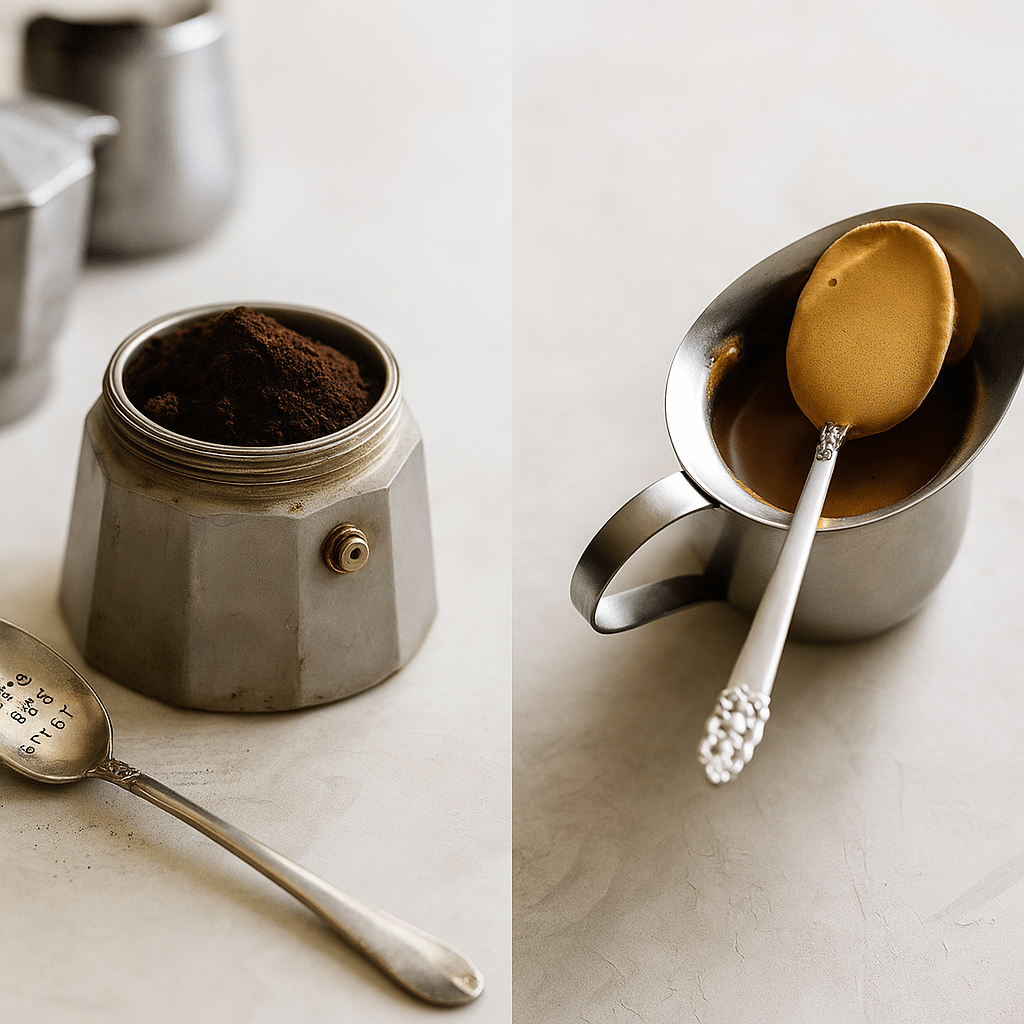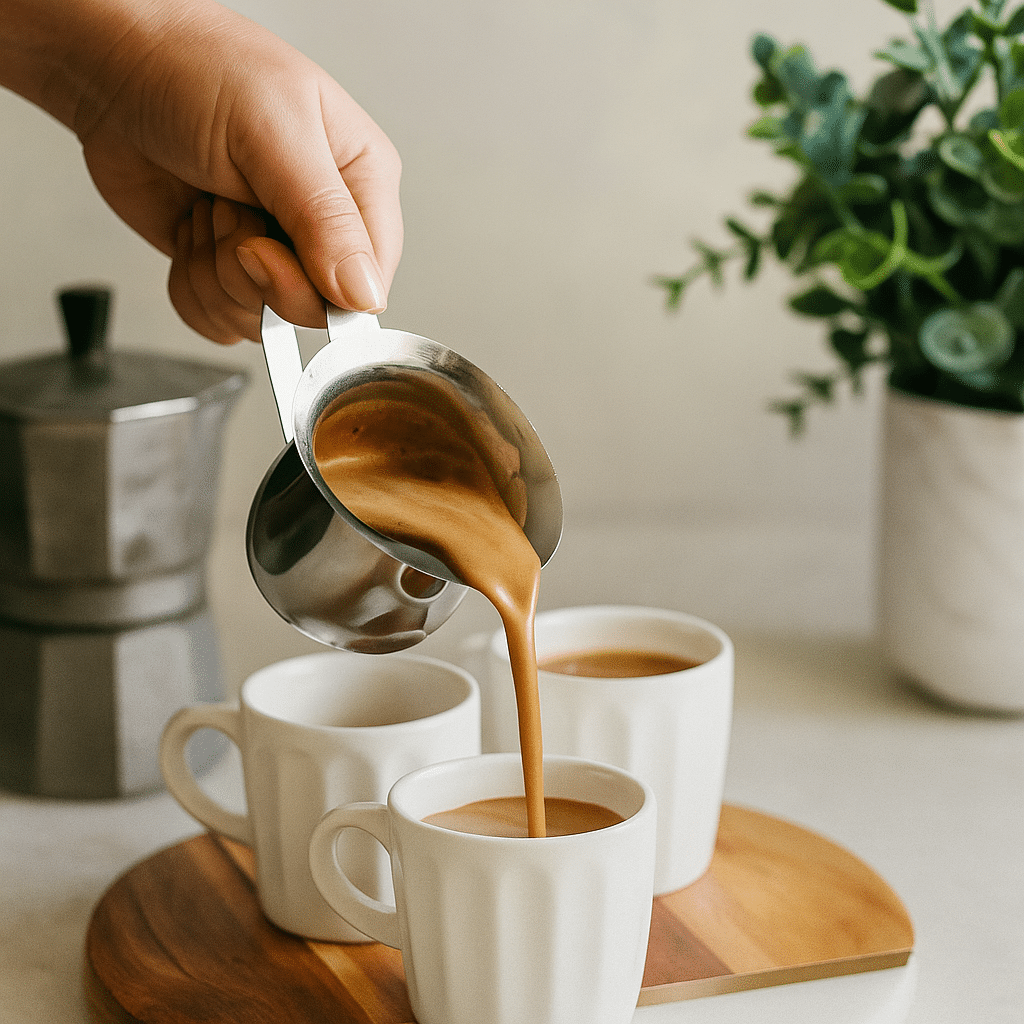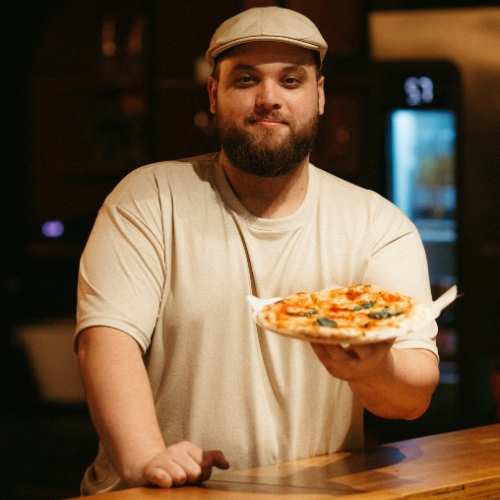Cafe Cuba drink is bold, sweet, and simple. I’m Edward Hale. I grew up in Texas kitchens, raised by a grandmother who believed food should matter. That mindset shaped how I cook, how I teach, and how I serve others.
The first time I tried a cafe Cuba drink, I was hooked. It’s not just coffee. It’s comfort. It’s meant to be shared. And it’s made with care. In this guide, I’ll show you how to make it right, using just a few basic tools and the right touch.

Table of Contents
What is Cafe Cuba Drink? Understanding the Cuban Coffee Tradition
The Origin of Café Cubano
The cafe Cuba drink is strong stovetop espresso mixed with whipped sugar foam, called espumita. You brew the coffee in a moka pot. Then you whip the first drops with sugar until it turns pale and thick. The rest of the coffee is poured on top.
It’s served in small cups. After meals. With guests. At home. At work. Always shared.
How It Compares to Regular Espresso
Cuban coffee is brewed differently. It’s sweet from the start, not bitter at the end.
| Type | Cafe Cuba Drink | Regular Espresso |
|---|---|---|
| Sweetening | Sugar whipped into first drops | Sugar added later |
| Brew Method | Moka pot on stove | Espresso machine |
| Taste and Feel | Sweet, smooth, strong | Bitter, bold, clean |
The cafe Cuba drink has balance. It’s strong, but easy to enjoy. The sugar brings it all together.
Why It Matters
This drink is about more than taste. It’s about pause. Connection. Habit. It may seem like a tiny step, but it truly adds that special touch. If you care about real food and real flavor, this belongs in your day.
Want something sweet to go with it? Try this Easter poke cake. It’s soft, rich, and just right next to Cuban coffee.
Print
Cafe Cuba Drink: How to Brew the Best Cuban Espresso
- Total Time: 15 minutes
- Yield: 4 small cups 1x
Description
The cafe Cuba drink is a bold, sweet Cuban espresso brewed in a moka pot and stirred with sugar foam, known as espumita. This traditional drink is small, strong, and served hot in tiny cups after meals or as a midday pick-me-up.
Ingredients
4 tablespoons dark roast ground coffee (Cuban style, like Bustelo or La Llave)
4 teaspoons white granulated sugar
Cold water (enough to fill the bottom chamber of your moka pot)
Instructions
Step 1: Set up the moka pot
Pour cold water into the bottom chamber until it’s just beneath the pressure valve. Add freshly ground coffee to the filter basket, keeping the surface level but loose. Screw the top and bottom parts of the pot together snugly.
Step 2: Begin the brew
Place the assembled moka pot over medium heat. As the coffee starts to bubble up, capture the very first drips into a separate small cup.
Step 3: Whip up the espumita
Immediately stir those first drops with a few teaspoons of sugar, whipping vigorously until the mixture turns into a thick, golden foam.
Step 4: Complete the coffee
Once the rest of the coffee has finished brewing, pour it slowly into the espumita mixture. Stir softly to blend the flavors and foam evenly.
Step 5: Time to serve
Carefully pour the sweetened coffee into espresso cups. Serve right away while it’s hot and fragrant, with the creamy sugar foam floating on top.
- Prep Time: 5 minutes
- Cook Time: 10 minutes
- Category: Drinks
- Cuisine: American
Nutrition
- Serving Size: 4
- Calories: 31 kcal
- Sugar: 8g
- Sodium: 1mg
- Carbohydrates: 8g
- Fiber: 0g
- Protein: 0g
Ingredients and Brewing Methods for Cafe Cuba Drink
Start With What Matters Most
To make a cafe Cuba drink the right way, you don’t need a fancy setup. What you need is good coffee, simple tools, and a few minutes of focus. This drink isn’t complicated, but it rewards care.
I’ve always believed that flavor comes from attention. Even a basic cup of coffee deserves that. Here’s how to get it right.
What You’ll Need
You only need three ingredients. Each one pulls its weight.
- Dark roast ground coffee. The darker the better. It should be strong, full-flavored, and rich. Cuban brands are great, but any bold roast will do the job.
- Granulated sugar. White sugar gives the cleanest foam. You’ll beat it with the first drops of coffee until it turns pale and creamy.
- Water. Plain, clean water. Nothing fancy.
For tools, keep it simple:
- Moka pot. This is the classic stovetop brewer. It’s what gives the cafe Cuba drink its strength and body.
- Heatproof cup. You’ll mix the sugar and coffee in this.
- Spoon. You’ll use it to stir until your arm says stop.
No machines. No hacks. Just honest technique.
How I Make It in My Kitchen
Here’s how I do it. It’s the same way I’d show a young cook who wants to learn it the right way.
Step 1: Brew the Coffee
Pour water into the lower chamber of your moka pot, stopping just below the safety valve. Add ground coffee to the filter, level it off, and screw the top on. Put it over medium heat. Wait until you hear the first hiss of espresso rising.
Step 2: Whip the Sugar Foam
Catch the first few drops of brewed coffee in your mixing cup. Add two to four teaspoons of sugar. Stir fast. It should turn thick and pale, almost like wet meringue. This is the heart of a proper cafe Cuba drink.
If it stays runny, add another drop or two of coffee and keep stirring.
Step 3: Combine and Serve
When the coffee finishes brewing, gently stream it over the sugar foam, letting it blend smoothly. Stir gently. Don’t rush it. Pour into small cups and serve hot. No milk. No ice. Just pure flavor.
Tips I Live By
- Use fresh coffee. Stale beans give a flat brew.
- Stir that foam like you mean it. Weak foam means a weak drink.
- Clean your moka pot often. Old oil ruins good coffee.
If you want something on the side, I’d suggest this roast beef sandwich. The bold flavor of the meat complements the deep, robust notes of the coffee beautifully.

Must-Try Cafe Cuba Drinks for Every Coffee Lover
The beauty of the cafe Cuba drink is that it’s not just one recipe. It’s a whole range of flavors built on the same strong foundation. Once you understand the base, you can start exploring its most loved variations. Each version tells a different story, but they all come from the same pot.
Let me walk you through the ones you should know. These are the ones I’ve made, served, and enjoyed with friends around the table.
Colada: The Shareable Shot
If you’ve ever walked into a Cuban bakery in Miami, you’ve probably seen someone walk out with a small foam cup and a handful of tiny plastic ones. That’s a colada. It’s a larger brew of sweet espresso, served with mini cups meant for sharing.
The cafe Cuba drink in this form is all about connection. At the salon. At work. Even outside the kitchen door during a break. One colada, five cups, one conversation.
You brew the espresso the same way. You make the sugar foam the same way. But you pour it into one larger cup, then let everyone take a sip from their own small one.
I like to think of it as Cuban espresso for the crew.
Cortadito: Bold with a Creamy Finish
A cortadito offers a smoother, more compact take on a café con leche. It blends strong Cuban espresso with just a splash of steamed milk for a creamy finish. The name means “little cut,” because the milk softens the edge of the coffee.
What I like about a cortadito is the balance. You still get the strength of the cafe Cuba drink, but the milk rounds it out just enough. It’s great mid-morning, especially with a sweet pastry or buttered toast.
You can adjust the ratio depending on how strong or smooth you like it. Just don’t skip the sugar foam. That part stays the same.
Café con Leche: A Classic Breakfast Pairing
This one’s simple, comforting, and often the first coffee a Cuban kid gets to try. It’s half strong coffee, half hot milk. No froth. No rush. Just a warm cup meant to start the day.
In Cuban homes, café con leche is often served with bread, sometimes dipped right in the cup. The drink is usually unsweetened until you add sugar to taste.
But here’s the trick. When I make it, I still start with a cafe Cuba drink. That base gives it depth and character, even when the milk mellows it out.
For more recipes, follow me on Pinterest or Instagram
Step-by-Step Cafe Cuba Drink Recipe for Home Baristas
Making a proper cafe Cuba drink at home isn’t about fancy gear. It’s about doing simple things well. I’ve made this drink in busy kitchens and at home, and I can tell you, once you get the feel for it, it becomes second nature.
Here’s my method. It’s the same one I’d show a young cook on their first prep shift. It’s consistent, straightforward, and highlights the true character of the coffee.
Step 1: Gather Your Tools and Ingredients
Before anything goes on the stove, set up your space.
What you’ll need:
- Moka pot
- Dark roast ground coffee
- White granulated sugar
- Cold water
- Small mixing cup
- Spoon
- Espresso cups
This drink isn’t about shortcuts. Good results come from using the right amount of each item and not rushing the process.
Step 2: Load the Moka Pot
Open the moka pot. Fill the bottom with water, just up to the safety valve. Add the ground coffee to the filter basket. Level it gently but don’t press it down. Screw the top on tight and place the pot on the stove over medium heat.
This part sets the base for your cafe Cuba drink, so take your time.
Step 3: Make the Espumita
As soon as the coffee starts coming out, grab the first few drops in a separate cup. These early drops are rich and full of flavor. Add about two teaspoons of sugar for each shot of coffee. Stir hard with your spoon. You’re looking for a light-colored, smooth foam. That’s your espumita.
This step takes feel. Stir fast and steady. It should be thick, but still pourable.
Step 4: Combine and Finish
Once the rest of the coffee has finished brewing, take the moka pot off the heat. Slowly pour the coffee into the sugar foam. Stir gently to mix. This creates the deep, sweet balance that makes the cafe Cuba drink stand out.
Step 5: Serve and Enjoy
Pour into small espresso cups. Serve right away. No milk, no ice, just pure, fresh-brewed flavor with that signature foam on top.
This is how I serve it in my kitchen. No extra steps, no tricks. Just solid technique and care in every move.
Pro Tips from the Line
- Keep your moka pot clean. Old buildup will ruin the taste.
- If your tap water has a noticeable flavor, opt for filtered water to preserve the coffee’s true taste.
- Practice the foam. Once you master it, it’ll become a step you never want to miss.
And if you’re serving this after a meal, I recommend this beef steak with mashed potatoes. The depth of the coffee and the richness of the meat balance each other perfectly.

Cafe Cuba Drink Pairings and Serving Traditions
The cafe Cuba drink isn’t just about taste. It’s about timing. It’s about how and when you serve it, and what you serve it with. Like a slow-cooked brisket or a fish just off the fire, it’s best enjoyed in the right moment, with the right company.
When to Serve a Cafe Cuba Drink
Traditionally, the cafe Cuba drink is served after meals. Not just in restaurants, but in homes, in small kitchens, and on patios with plastic chairs. It’s a reset. A close to the meal. A reason to slow down and sit for a few more minutes.
In my kitchen, I like to serve it as a final course. No dessert yet. Just the espresso and a clean cup. It gives people time to talk, digest, and settle in. And if someone’s stopping by mid-afternoon, I’ll pour a shot then too. No need for an occasion.
The Best Foods to Pair with Cafe Cuba Drink
The drink is rich and sweet, so it pairs well with foods that have body and contrast. Here’s what I like to serve with it:
1. Cuban Pastries
You can’t go wrong with a pastelito. Guava, cheese, or coconut. The flakiness and light sweetness work beautifully with the strong espresso.
2. Buttered Toast
It sounds simple, but Cuban toast with a bit of salted butter is perfect next to a hot cafe Cuba drink. The crunch of the bread and the smoothness of the drink are a match.
3. Ham or Cheese Croquettes
In my kitchen, we go for classics like beef or chicken croquettes as our go-to options. They offer the same creamy inside and crispy outside, and they balance out the sugar in the coffee.
4. Light Cakes
Think vanilla sponge or plain pound cake. No frosting, no extras. Just soft texture to absorb the coffee’s strength. One of my regular guests always asks for a small piece of cornbread with hers. I get it. It works.
Modern Touches That Still Respect the Tradition
If you’re in the U.S. and want to respect the drink’s roots without using pork or alcohol, don’t worry. There are plenty of smart swaps.
- Use beef croquettes or plantain-based sides
- Stick with milk-free pastries if serving a cortadito variation
- Offer a small fruit plate or a spoon of sweet jam on toast
What matters most is how you serve it. The cafe Cuba drink is small in size but rich in meaning. It says, “You’re welcome here.” It says, “Sit down for a minute.”
If you want a savory dish to round out your table, try this teres major steak. It’s tender, simple, and stands up to strong coffee without clashing.
Popular Cuban Coffee Brands and Alternatives in the USA
If you want a true cafe Cuba drink, it starts with the right coffee. You don’t need the most expensive beans or rare imports, but you do need a roast that delivers strength, depth, and a bold finish.
Cuban coffee has a style all its own. It’s roasted darker, ground finer, and brewed to stand up to sugar and tradition. Below are the top brands I trust and what to use if those aren’t on the shelf.
Top Cuban Coffee Brands Worth Using
1. Café Bustelo
This brand has been around forever, and for good reason. It’s bold, rich, and widely available across the U.S. grocery stores. For anyone making a Café Cuba drink for the first time, this is the brand I trust and always point them to. It gives you that punchy base the sugar foam needs.
2. La Llave
A little more robust than Bustelo, La Llave has a slightly oilier grind and a deeper roast. You’ll find it in Latin markets and sometimes in bulk stores. It carries a smoky kick that hits the spot when I’m craving a bolder flavor.
3. Pilon
Another solid choice. Pilon has a rounder body and a hint of sweetness. It works well in cortaditos or café con leche. I reach for this when I’m pairing the cafe Cuba drink with buttery toast or a light pastry.
All three brands are made for moka pot brewing. They’re ground just right and built to hold up to high pressure and sugar foam.
American Substitutes That Work
Can’t find Cuban coffee? No problem. Choose a dark roast espresso blend from a local roaster or a reputable national brand you trust. Here’s what to watch for:
- Choose whole bean or fine-ground espresso
- Look for words like “bold,” “Italian,” or “dark roast” on the label
- Avoid anything labeled light, blonde, or medium roast
What you want is coffee that smells like roasted chocolate and tastes deep, not acidic.
Pre-Ground vs. Fresh Ground
If you’re using pre-ground Cuban coffee, make sure it’s stored well. Once it’s open, keep it in an airtight container.When time allows, I prefer to grind my beans fresh for the best flavor. It adds just a bit more life to the brew.
Fresh or not, the quality of the roast makes all the difference in the final cafe Cuba drink.
What to Skip
Avoid flavored coffees, anything with artificial sweeteners mixed in, or light roast blends. These won’t produce the right body or blend well with sugar foam.
And always skip the drip machine. This drink needs pressure. The moka pot gives it that.
For a bold plate to go with a bold brew, take a look at this picanha steak guide. It’s rich, flavorful, and pairs just right with a hot cup of café cubano.
Cafe Cuba Drink Culture in Miami and Beyond
The cafe Cuba drink is more than a way to get caffeine. It’s part of the rhythm of daily life. In some places, it’s tied to memory. In others, it’s simply tradition. But wherever it’s poured, it means something.
A Daily Habit with Deep Roots
In Miami, this drink is woven into the day. I remember walking through a neighborhood market and hearing that familiar hiss from a moka pot. You could smell roasted coffee before you stepped inside. Behind the counter, someone was making a small batch and pouring it into foam cups.
It wasn’t for sale. It was being shared. One for a delivery driver, one for the prep cook, one for a neighbor dropping in. No one asked. It just happened. That’s the kind of coffee the cafe Cuba drink is. Quiet, strong, and full of generosity.
How It’s Served in Homes
In Cuban households, no one needs to request coffee. It simply appears. After dinner, or sometimes in the middle of the afternoon, someone starts heating the moka pot. Sugar is ready. Small cups come out. It’s all done without a fuss.
I’ve been in kitchens where the food was finished, the plates cleared, and before anyone could say a word, there was hot coffee on the table. That moment, when everything slows down and people lean in with a cup in hand, that’s the real power of the cafe Cuba drink.
It doesn’t demand attention. It earns it, just by showing up at the right time.
You Don’t Need Miami to Keep the Tradition Alive
This drink travels well. I’ve brewed it in tiny diners off the highway, out on the porch after a long day of cooking, and in the back of my own restaurant with a crew that needed a boost.
The ingredients are simple. What gives it meaning is the way it’s offered. Whether you live in a big city or a quiet town, you can bring this tradition into your space. Start with the brew. Add the foam. Serve it hot and with care.
If you pair it with good food and better company, the cafe Cuba drink will always feel right at home.
Need something to serve with it? Take a look at this firecracker steak and shrimp. It brings the same energy to the table, bold and full of flavor.
Conclusion
The cafe Cuba drink is simple, strong, and full of tradition. You don’t need much to make it, just good coffee, sugar, and care. It’s not about caffeine. It’s about pause. About sharing something small that means something bigger.
I’ve worked in fast kitchens and quiet ones, but this drink always brings the same feeling. Warmth. Balance. A moment to breathe.
Serve it with intention. Enjoy it fresh. Pass it to someone who needs it.
That’s what the cafe Cuba drink is really about.
If you want something filling to go with it, try this instant pot corned beef. It holds its own next to a bold cup.
Frequently Asked Questions About Cafe Cuba Drink
Why was Cafe Cuba discontinued?
The ready-to-drink product called Cafe Cuba, made by a beverage brand, didn’t last long. It never caught on the way traditional Cuban coffee did. But that version is not the same as the cafe Cuba drink made at home. The real one, brewed fresh in a moka pot with sugar foam, is alive and well in Cuban kitchens and across the U.S.
What is café cubano made of?
The classic cafe Cuba drink has just three ingredients: finely ground dark roast coffee, white sugar, and water. It’s brewed in a moka pot, and the sugar is whipped into a creamy foam with the first drops of coffee. That foam, called espumita, gives it its signature look and taste.
Is café cubano strong?
Yes. The cafe Cuba drink is very strong, but the sugar softens the punch. The moka pot brews under pressure, giving the coffee an intense, concentrated flavor. It’s small in size for a reason. One shot carries a lot of energy.
How to make a cafecito?
To make a proper cafecito, start by brewing dark roast espresso in a moka pot. Catch the first few drops and mix them with sugar. Beat them until they turn thick and pale. That’s the foam. Slowly pour in the remaining coffee and stir gently to blend the flavors. Serve it hot and fresh. That’s the true cafe Cuba drink.





